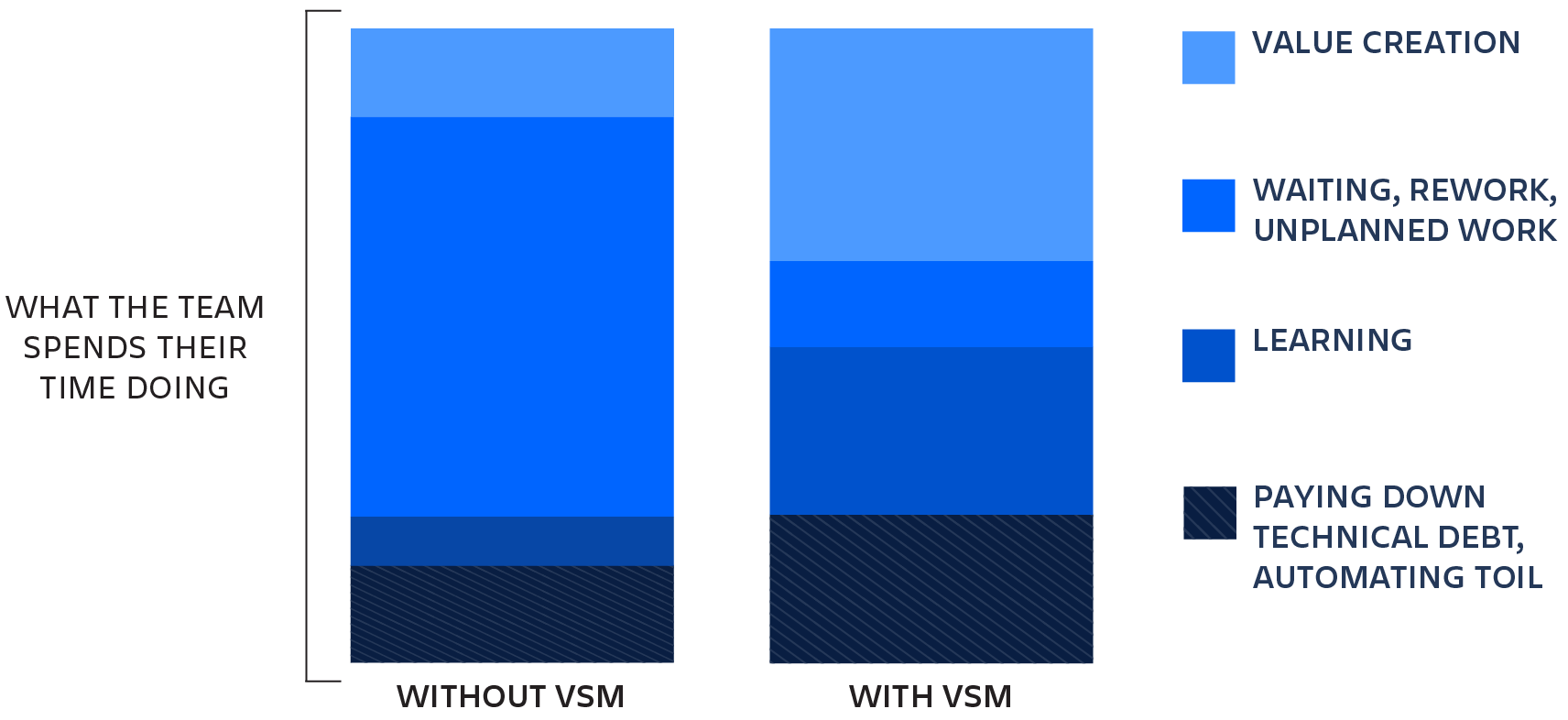Key Takeaways
Value stream management (VSM) optimizes the flow of value from idea to customer, improving delivery speed and quality.
VSM connects business strategy with Agile and DevOps teams, breaking down silos and aligning around customer outcomes.
Mapping value streams reveals bottlenecks, inefficiencies, and opportunities for improvement.
Implement VSM to increase predictability, customer satisfaction, and innovation across your organization.
什么是价值流管理 (VSM),它为何重要?
软件是许多行业的关键差异化因素。公司将客户请求转化为可交付功能所花费的时间长短会影响长期成功。
拥有能让客户满意的数字产品与服务的灵活企业,能抢占市场份额并提升营收,而反应迟缓的企业则会举步维艰。
为了保持竞争力,大型组织已经推出了企业敏捷性举措。并非所有这些举措都像预期的那样成功,原因有很多,包括组织层面的阻力、领导力不足和缺乏一致性。由于经济不确定性导致企业削减人员和预算,简化产品交付就显得尤为重要。价值流管理可以重振企业敏捷性工作,提供一种满足客户需求、适应市场变化和更具可预测性的交付方式。
什么是价值流管理 (VSM)?
价值流管理是一套实践方法,旨在改进团队交付高质量客户体验的方式。VSM 侧重于两件事—客户要求的功能或更新的交付速度以及客户是否从这些变化中实现了价值。根据 Forrester 所言,“价值流管理 (VSM) 有可能彻底改变大规模软件的融资、构建、管理和维护流程。”价值流管理的根源可追溯至精益制造,并与 20 世纪 50 年代的丰田生产体系 (TPS) 相联系。这种系统化的方法旨在缩短价值实现时间并提供更高质量的产品。价值流管理有助于连接高管层与敏捷和 DevOps 团队,从而围绕客户满意度达成一致。价值流管理能够带来以下益处:
更快地交付以客户为中心的产品,提高竞争力和收入
更好的客户体验,带来正面评价和推荐
提升了员工在跨职能团队中的参与度,让员工能看到全局,而非仅关注自身所在的孤立领域
基于数据与洞察信息的未来投资决策
什么是价值流?
Gartner 将价值流定义为“向内部或外部客户提供产品、服务或体验所必需的一系列活动”。价值流已经存在于公司中,即使它们未被明确标注。了解您的价值流可以让您做出更好的投资决策,从而避免资源浪费。价值流包括从想法产生到向客户交付价值的过程中的每一个接触点。若缺乏这种认知,您将难以知道有效环节与问题所在。例如,您可能会发现团队间的交接过程存在长时间的延迟,这会损害工作效率和质量。
软件开发中的价值流
价值流和 DevOps 都植根于精益原则。作为价值流进行思考和工作可以帮助技术团队确定软件开发中需要改进的领域并确定优先顺序。DevOps 提供改善价值流交付的实践和工具。通过专注于流程优化,可以发现效率低下的地方并简化流程。
什么是价值流映射?
价值流图绘制是一种可视化协作技术,用于通过识别和分析向客户提供产品或服务所需的活动流程来描述价值流。绘制价值流图可以揭示依赖关系、障碍、效率低下和浪费,这些问题会导致预算超支和交付延误。为了绘制价值流,跨职能团队需收集数据以确定步骤并测算每个步骤的接触时间和闲置时间。这样一来,当他们将所有接触时间与闲置时间相加时,就能计算出该价值流的周期时间。借助白板或绘图软件进行可视化协作,团队可从客户视角明确区分增值与非增值项目。他们还可以确定问题领域,例如人手不足的团队会阻碍其他团队推进的情况。
为什么价值流管理很重要?
客户声称的需求(从客户支持或销售团队等渠道收集)与实际交付内容之间往往存在脱节。业务团队与技术团队之间缺乏有效的沟通是导致此问题的部分原因。高管层关注目标与整体战略,而技术负责人则常围绕交付节奏和技术产出展开沟通。领导者及其团队需要建立统一的沟通语言和更高效的沟通渠道,以实现以客户目标与体验为核心的对齐协调。价值流管理能促进跨团队沟通,从而改善信息流和价值创造。客户通过销售或支持团队请求功能、产品团队设计功能、工程团队构建软件和产品交付。在跨职能团队中让每个团队都有一名代表,能更高效精准地交付符合需求的产品。VSM 解决的问题包括:
客户对当前的产品感到沮丧
缺陷修复和新功能或产品的交付速度缓慢
竞争对手能快速顺应市场变化,导致自身丢失市场份额
由于裁员和其他削减成本的措施,资源减少
敏捷和/或数字化转型未能达到预期成效
由于部门壁垒和数据分散,整个组织内部缺乏透明度
组织结构未围绕价值创造进行设计

价值流管理的好处是什么?
一旦确定并绘制了价值流图,企业就可以对其进行分析以创建新的产品或功能。他们可以利用价值流中的实时数据驱动型洞察信息来做出更好的业务决策,例如客户对当前产品的看法以及需要更改的内容。不必投资单个项目,而是为整个价值流提供资金,从而提供灵活性以适应不断变化的客户需求,而无需再申请新预算。价值流管理的好处包括:
提升可预测性。
了解整个价值流有助于减少导致错过截止时间的不确定性和意外情况。
提升客户满意度。
快速响应客户请求可以改善他们的体验和公司的声誉。
提升工作效率。
简化运营和减少障碍使团队能够更快地进行构思、测试和交付。
降低成本。
识别出不必要的工作与被浪费的资源,能节省资金和时间。
优化软件。
自动执行手动任务可以腾出时间进行创新,减少出现错误和缺陷的机会。
提升端到端的可见性。
在整个组织中提供实时数据可以让员工跟踪举措并适应不断变化的公司优先级。
推动创新和提高士气。
专注于对客户真正重要的产品能让开发人员获得更高的工作满意度。
价值流管理解决方案
价值流管理解决方案可帮助领导者提升整个组织的价值流思维,从而提高团队的效率。团队需要实时访问数据和报告,以了解流程是否顺利进行。他们可以使用 VSM 工具推动持续改进,并将投资与客户价值相关联。VSM 软件解决方案通过以下方式在不减慢团队速度的情况下扩大协作规模:
提供打破企业孤岛的整合视图
将公司各个层面的人员、工作和时间联系起来
合并来自异构工具链等不同来源的数据
在不中断日常运营的情况下创建单一数据源
持续强化敏捷最佳实践
使用您选择的框架,例如 SAFe、Scrum@Scale、LeSS、规范敏捷开发、Spotify 或混合框架。
为各个级别的团队提供工具——从高管到发布培训
主动管理跨团队依赖关系以提高可预测性
通过缩短反馈回路,创造持续改进的环境
衡量并分析关键要素
VSM 解决方案允许团队自主采取行动,交付客户要求的产品,然后分析这些产品是否为客户体验带来了切实的、可衡量的变化,并对所学内容做出回应。
用于衡量目标和进度的价值流指标
许多企业缺乏可见性和综合报告,尤其是那些高度矩阵化的企业。价值流管理解决方案打破了孤岛,汇集了不同的数据,为您提供所需的指标和可行的见解。
流量指标
流动指标用于评估相对于预期业务成果的价值交付速率。
流速
用于衡量价值流中在特定时间段内完成的价值单位的数量。
流动时间
用于衡量从价值流中某个价值单元启动工作到发布给客户所需的时间。过长的流动时间可能意味着效率低下或存在瓶颈。
流动负载
用于衡量在制品 (WIP) 数量,该指标是预示价值流内部效率问题的先导指标。
流动效率
用于衡量价值单元被实际处理的时间占总流动时间的比例。较低的流动效率可能意味着步骤之间存在冗长的等待时间,从而导致大量队列和更多的在制品积压。
流动分布
用于衡量一段时间内上述流动项的完成比例。这对于确定实现公司和团队目标所需工作的优先顺序很有用。
DORA 指标
DORA 指标用于评估和提高 DevOps 团队的效率。
变更的提前期
是指从代码变更提交到主干分支到它处于可部署状态之间的时间长度。
变更失败率
是指投入生产后需要热修复或其他补救措施的代码变更百分比。
部署频率
衡量新代码部署到生产环境的频率,可用于衡量团队的速度和敏捷性。
平均恢复时间 (MTTR)
用于衡量从部分服务中断或完全故障中恢复所需的时间。
目标和关键成果 (OKR)
企业需要确保团队完成的工作与企业目标保持一致。目标和关键成果 (OKR) 有两个组成部分:您想要实现的目标和衡量成功的关键成果。高管层制定与组织的使命、愿景和核心价值观相关的高级 OKR。各个团队通过设置自己的团队级 OKR 来决定如何实现这些目标。OKR 可以按季度设置,以便根据新数据或市场变化更快地做出调整或坚决的决策。跟踪 OKR,以查看活动的当前状态,例如活动是否按时推进、存在风险或处于受阻状态。
VSM 如何提高价值实现?
价值实现的核心在于确保推进正确的工作项,达成预期成果,并为下一轮的产品开发周期提供支持。尽管优先级通常赋予新产品或功能开发而非系统性改进,但在对功能、缺陷、技术债务和风险进行投资时仍需全局考量。价值实现可分为两类:
输出(价值流运行状况)
产出与从想法到实现和为客户提供持续价值流的工作流程息息相关。改进底层交付系统(人员、流程和技术)可以腾出更多时间来创造价值。通过衡量工作分配和周期时间,团队可以看到他们的行为如何影响他们提供新功能和增加容量的能力。
成果(客户体验)
通过衡量客户体验,团队可以查看他们是否提供了所需的客户价值,例如增加的客户使用量或正面评价。这些指标(基于数据、反馈和分析)为团队提供了做出未来决策和投资所需的信息。
Key Takeaways
Value stream management (VSM) optimizes the flow of value from idea to customer, improving delivery speed and quality.
VSM connects business strategy with Agile and DevOps teams, breaking down silos and aligning around customer outcomes.
Mapping value streams reveals bottlenecks, inefficiencies, and opportunities for improvement.
Implement VSM to increase predictability, customer satisfaction, and innovation across your organization.
什么是价值流管理 (VSM),它为何重要?
软件是许多行业的关键差异化因素。公司将客户请求转化为可交付功能所花费的时间长短会影响长期成功。
拥有能让客户满意的数字产品与服务的灵活企业,能抢占市场份额并提升营收,而反应迟缓的企业则会举步维艰。
为了保持竞争力,大型组织已经推出了企业敏捷性举措。并非所有这些举措都像预期的那样成功,原因有很多,包括组织层面的阻力、领导力不足和缺乏一致性。由于经济不确定性导致企业削减人员和预算,简化产品交付就显得尤为重要。价值流管理可以重振企业敏捷性工作,提供一种满足客户需求、适应市场变化和更具可预测性的交付方式。
什么是价值流管理 (VSM)?
价值流管理是一套实践方法,旨在改进团队交付高质量客户体验的方式。VSM 侧重于两件事—客户要求的功能或更新的交付速度以及客户是否从这些变化中实现了价值。根据 Forrester 所言,“价值流管理 (VSM) 有可能彻底改变大规模软件的融资、构建、管理和维护流程。”价值流管理的根源可追溯至精益制造,并与 20 世纪 50 年代的丰田生产体系 (TPS) 相联系。这种系统化的方法旨在缩短价值实现时间并提供更高质量的产品。价值流管理有助于连接高管层与敏捷和 DevOps 团队,从而围绕客户满意度达成一致。价值流管理能够带来以下益处:
更快地交付以客户为中心的产品,提高竞争力和收入
更好的客户体验,带来正面评价和推荐
提升了员工在跨职能团队中的参与度,让员工能看到全局,而非仅关注自身所在的孤立领域
基于数据与洞察信息的未来投资决策
什么是价值流?
Gartner 将价值流定义为“向内部或外部客户提供产品、服务或体验所必需的一系列活动”。价值流已经存在于公司中,即使它们未被明确标注。了解您的价值流可以让您做出更好的投资决策,从而避免资源浪费。价值流包括从想法产生到向客户交付价值的过程中的每一个接触点。若缺乏这种认知,您将难以知道有效环节与问题所在。例如,您可能会发现团队间的交接过程存在长时间的延迟,这会损害工作效率和质量。
软件开发中的价值流
价值流和 DevOps 都植根于精益原则。作为价值流进行思考和工作可以帮助技术团队确定软件开发中需要改进的领域并确定优先顺序。DevOps 提供改善价值流交付的实践和工具。通过专注于流程优化,可以发现效率低下的地方并简化流程。
什么是价值流映射?
价值流图绘制是一种可视化协作技术,用于通过识别和分析向客户提供产品或服务所需的活动流程来描述价值流。绘制价值流图可以揭示依赖关系、障碍、效率低下和浪费,这些问题会导致预算超支和交付延误。为了绘制价值流,跨职能团队需收集数据以确定步骤并测算每个步骤的接触时间和闲置时间。这样一来,当他们将所有接触时间与闲置时间相加时,就能计算出该价值流的周期时间。借助白板或绘图软件进行可视化协作,团队可从客户视角明确区分增值与非增值项目。他们还可以确定问题领域,例如人手不足的团队会阻碍其他团队推进的情况。
为什么价值流管理很重要?
客户声称的需求(从客户支持或销售团队等渠道收集)与实际交付内容之间往往存在脱节。业务团队与技术团队之间缺乏有效的沟通是导致此问题的部分原因。高管层关注目标与整体战略,而技术负责人则常围绕交付节奏和技术产出展开沟通。领导者及其团队需要建立统一的沟通语言和更高效的沟通渠道,以实现以客户目标与体验为核心的对齐协调。价值流管理能促进跨团队沟通,从而改善信息流和价值创造。客户通过销售或支持团队请求功能、产品团队设计功能、工程团队构建软件和产品交付。在跨职能团队中让每个团队都有一名代表,能更高效精准地交付符合需求的产品。VSM 解决的问题包括:
客户对当前的产品感到沮丧
缺陷修复和新功能或产品的交付速度缓慢
竞争对手能快速顺应市场变化,导致自身丢失市场份额
由于裁员和其他削减成本的措施,资源减少
敏捷和/或数字化转型未能达到预期成效
由于部门壁垒和数据分散,整个组织内部缺乏透明度
组织结构未围绕价值创造进行设计

价值流管理的好处是什么?
一旦确定并绘制了价值流图,企业就可以对其进行分析以创建新的产品或功能。他们可以利用价值流中的实时数据驱动型洞察信息来做出更好的业务决策,例如客户对当前产品的看法以及需要更改的内容。不必投资单个项目,而是为整个价值流提供资金,从而提供灵活性以适应不断变化的客户需求,而无需再申请新预算。价值流管理的好处包括:
提升可预测性。
了解整个价值流有助于减少导致错过截止时间的不确定性和意外情况。
提升客户满意度。
快速响应客户请求可以改善他们的体验和公司的声誉。
提升工作效率。
简化运营和减少障碍使团队能够更快地进行构思、测试和交付。
降低成本。
识别出不必要的工作与被浪费的资源,能节省资金和时间。
优化软件。
自动执行手动任务可以腾出时间进行创新,减少出现错误和缺陷的机会。
提升端到端的可见性。
在整个组织中提供实时数据可以让员工跟踪举措并适应不断变化的公司优先级。
推动创新和提高士气。
专注于对客户真正重要的产品能让开发人员获得更高的工作满意度。
价值流管理解决方案
价值流管理解决方案可帮助领导者提升整个组织的价值流思维,从而提高团队的效率。团队需要实时访问数据和报告,以了解流程是否顺利进行。他们可以使用 VSM 工具推动持续改进,并将投资与客户价值相关联。VSM 软件解决方案通过以下方式在不减慢团队速度的情况下扩大协作规模:
提供打破企业孤岛的整合视图
将公司各个层面的人员、工作和时间联系起来
合并来自异构工具链等不同来源的数据
在不中断日常运营的情况下创建单一数据源
持续强化敏捷最佳实践
使用您选择的框架,例如 SAFe、Scrum@Scale、LeSS、规范敏捷开发、Spotify 或混合框架。
为各个级别的团队提供工具——从高管到发布培训
主动管理跨团队依赖关系以提高可预测性
通过缩短反馈回路,创造持续改进的环境
衡量并分析关键要素
VSM 解决方案允许团队自主采取行动,交付客户要求的产品,然后分析这些产品是否为客户体验带来了切实的、可衡量的变化,并对所学内容做出回应。
用于衡量目标和进度的价值流指标
许多企业缺乏可见性和综合报告,尤其是那些高度矩阵化的企业。价值流管理解决方案打破了孤岛,汇集了不同的数据,为您提供所需的指标和可行的见解。
流量指标
流动指标用于评估相对于预期业务成果的价值交付速率。
流速
用于衡量价值流中在特定时间段内完成的价值单位的数量。
流动时间
用于衡量从价值流中某个价值单元启动工作到发布给客户所需的时间。过长的流动时间可能意味着效率低下或存在瓶颈。
流动负载
用于衡量在制品 (WIP) 数量,该指标是预示价值流内部效率问题的先导指标。
流动效率
用于衡量价值单元被实际处理的时间占总流动时间的比例。较低的流动效率可能意味着步骤之间存在冗长的等待时间,从而导致大量队列和更多的在制品积压。
流动分布
用于衡量一段时间内上述流动项的完成比例。这对于确定实现公司和团队目标所需工作的优先顺序很有用。
DORA 指标
DORA 指标用于评估和提高 DevOps 团队的效率。
变更的提前期
是指从代码变更提交到主干分支到它处于可部署状态之间的时间长度。
变更失败率
是指投入生产后需要热修复或其他补救措施的代码变更百分比。
部署频率
衡量新代码部署到生产环境的频率,可用于衡量团队的速度和敏捷性。
平均恢复时间 (MTTR)
用于衡量从部分服务中断或完全故障中恢复所需的时间。
目标和关键成果 (OKR)
企业需要确保团队完成的工作与企业目标保持一致。目标和关键成果 (OKR) 有两个组成部分:您想要实现的目标和衡量成功的关键成果。高管层制定与组织的使命、愿景和核心价值观相关的高级 OKR。各个团队通过设置自己的团队级 OKR 来决定如何实现这些目标。OKR 可以按季度设置,以便根据新数据或市场变化更快地做出调整或坚决的决策。跟踪 OKR,以查看活动的当前状态,例如活动是否按时推进、存在风险或处于受阻状态。
VSM 如何提高价值实现?
价值实现的核心在于确保推进正确的工作项,达成预期成果,并为下一轮的产品开发周期提供支持。尽管优先级通常赋予新产品或功能开发而非系统性改进,但在对功能、缺陷、技术债务和风险进行投资时仍需全局考量。价值实现可分为两类:
输出(价值流运行状况)
产出与从想法到实现和为客户提供持续价值流的工作流程息息相关。改进底层交付系统(人员、流程和技术)可以腾出更多时间来创造价值。通过衡量工作分配和周期时间,团队可以看到他们的行为如何影响他们提供新功能和增加容量的能力。
成果(客户体验)
通过衡量客户体验,团队可以查看他们是否提供了所需的客户价值,例如增加的客户使用量或正面评价。这些指标(基于数据、反馈和分析)为团队提供了做出未来决策和投资所需的信息。
